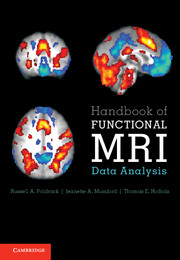Book contents
- Frontmatter
- Contents
- Preface
- 1 Introduction
- 2 Image processing basics
- 3 Preprocessing fMRI data
- 4 Spatial normalization
- 5 Statistical modeling: Single subject analysis
- 6 Statistical modeling: Group analysis
- 7 Statistical inference on images
- 8 Modeling brain connectivity
- 9 Multivoxel pattern analysis and machine learning
- 10 Visualizing, localizing, and reporting fMRI data
- Appendix A A Review of the General Linear Model
- Appendix B Data organization and management
- Appendix C Image formats
- Bibliography
- Index
Preface
Published online by Cambridge University Press: 01 June 2011
- Frontmatter
- Contents
- Preface
- 1 Introduction
- 2 Image processing basics
- 3 Preprocessing fMRI data
- 4 Spatial normalization
- 5 Statistical modeling: Single subject analysis
- 6 Statistical modeling: Group analysis
- 7 Statistical inference on images
- 8 Modeling brain connectivity
- 9 Multivoxel pattern analysis and machine learning
- 10 Visualizing, localizing, and reporting fMRI data
- Appendix A A Review of the General Linear Model
- Appendix B Data organization and management
- Appendix C Image formats
- Bibliography
- Index
Summary
Functional magnetic resonance imaging (fMRI) has, in less than two decades, become the most commonly used method for the study of human brain function. FMRI is a technique that uses magnetic resonance imaging to measure brain activity by measuring changes in the local oxygenation of blood, which in turn reflects the amount of local brain activity. The analysis of fMRI data is exceedingly complex, requiring the use of sophisticated techniques from signal and image processing and statistics in order to go from the raw data to the finished product, which is generally a statistical map showing which brain regions responded to some particular manipulation of mental or perceptual functions. There are now several software packages available for the processing and analysis of fMRI data, several of which are freely available.
The purpose of this book is to provide researchers with a sophisticated understanding of all of the techniques necessary for processing and analysis of fMRI data. The content is organized roughly in line with the standard flow of data processing operations, or processing stream, used in fMRI data analysis. After starting with a general introduction to fMRI, the chapters walk through all the steps that one takes in analyzing an fMRI dataset. We begin with an overview of basic image processing methods, providing an introduction to the kinds of data that are used in fMRI and how they can be transformed and filtered.
- Type
- Chapter
- Information
- Handbook of Functional MRI Data Analysis , pp. ix - xPublisher: Cambridge University PressPrint publication year: 2011



